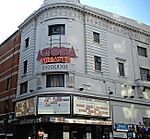Outernet London
Buildings and structures in the City of WestminsterLists of places in LondonPrivately owned public spacesRedevelopment projects in LondonTottenham Court Road

Outernet London is an entertainment, arts and culture district opened in 2022 in the West End of London. Named as "London's most visited tourist attraction" by The Times newspaper in 2023, it is the largest digital exhibition space in Europe with the "world's largest LED screen deployment". It is located adjacent to the eastern exit of the new Elizabeth line Tottenham Court Road Underground station, on the southern side of the public square, and it extends to Denmark Street - “Tin Pan Alley”, with St Giles High Street to the east and Charing Cross Road to the west.
Excerpt from the Wikipedia article Outernet London (License: CC BY-SA 3.0, Authors, Images).Outernet London
St Giles Square, London Bloomsbury (London Borough of Camden)
Geographical coordinates (GPS) Address Nearby Places Show on map
Geographical coordinates (GPS)
| Latitude | Longitude |
|---|---|
| N 51.5159 ° | E -0.13 ° |
Address
St Giles Square
St Giles Square
W1T 7RJ London, Bloomsbury (London Borough of Camden)
England, United Kingdom
Open on Google Maps






